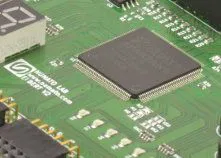Table of Contents:
The 3B+ model is a minicomputer classified as one of the 3. generation of devices in the popular Raspberry Pi series. What distinguishes this equipment and what is worth knowing about it?
First of all - what is Raspberry Pi?
Raspberry Pi is a series of devices familiar to any electronics enthusiast. These are single-board miniature computers originally designed for practical computer science in schools. However, the platform with the now almost iconic raspberry in its logo has quickly gained popularity as hardware used in many robotics projects and beyond. Due to their relatively powerful components and the availability of interfaces such as HDMI and USB, Raspberry Pi minicomputers are eagerly used by hobbyists with a variety of interests, as well as by programmers.
It’s been more than 10 years since the release of the first product in the series, and in that time several more releases of the Raspberry Pi have seen the light of day – October 23 saw the launch of the fifth-generation flagship device. The manufacturer also provides a dedicated operating system, Raspberry Pi OS (formerly – Raspbian), based on a Linux distribution called Debian.
Raspberry Pi 3B+ - a third-generation minicomputer in an even better design
Despite the appearance of the fifth generation of the “raspberry”, it is still worth paying attention to the earlier offerings in the series. As the Raspberry Pi evolved, more devices received more powerful components, unlocking entirely new possibilities for do-it-yourselfers and programmers – an example is the 3B+ model, which is an upgraded version of the Raspberry Pi 3B. Its launch took place on March 14, 2018, two years after the introduction of the 3B model.
The two versions are very similar in terms of functionality and format, but the technical specifications contain several important differences. The 3B+ model featured, among other things. slightly more powerful processor; the manufacturer has also introduced support for 5 GHz Wi-Fi, Bluetooth 4.2 (in the 3B – only 2.4 GHz Bluetooth 4.1) and PoE (Power over Ethernet) technology, which allows power to be supplied over an Ethernet cable. In terms of power supply, it is also worth noting the slightly lower input current requirements – to supply power to the Raspberry Pi 3B+, 1.13 A instead of 1.34 A is already sufficient.
Raspberry Pi 3B+ - components
The most important component of the minicomputer is, of course, the processor – this model uses a 64-bit Cortex-A53 chip with Broadcom VideoCore IV graphics (250 MHz). Computing units in this series are a common sight, among others. in smartphones due to its very low power consumption relative to the performance offered. This also makes them ideal for devices such as the Raspberry Pi 3B+. The processor uses 4 cores with a base clock speed of 1.4 GHz and is made on ARM architecture.
The device supports 1 GB of LPDDR2-type RAM. In addition, you will find numerous external connectors, such as:
- Full-size HDMI port,
- RJ-45 connector,
- four USB 2.0 connectors,
- micro USB power port,
- audio connector (3.5 mm mini jack).
The data is stored on a microSD card. The board supports a standard GPIO interface (40 pins), as well as a DSI (Display Serial Interface) for connecting a touch-enabled LCD/LED display. On top of that, Raspberry Pi 3B+ users have access to the Camera Serial Interface (CSI) camera port.
One of the main differences from the standard 3B model is better support for communications technology. The Raspberry Pi 3B+ can count on support for Wi-Fi 5 (802.11b/g/n/ac) at 2.4 GHz or GHz, as well as Gigabit Ethernet data transfer via USB. In addition, the board is equipped with a Bluetooth version 4.2 adapter, which allows you to conveniently connect various wireless components and communicate with different equipment.
What can the Raspberry Pi 3B+ be used for?
Raspberry Pi 3B+ is a microcontroller equipped with a number of key components that enable the preparation of many interesting projects. Here you’ll find a processor with an integrated graphics chip, a USB port, I/O pins and extensive support for various data transfer methods – including wireless. Such a configuration makes the Raspberry Pi 3B+ applicable not only in the field of electronics, but also to implement virtually all functions available on a standard computer. In the context of robotics, the 3B+ model will work well, among other things. As a controller for a small robot. However, these are just examples of the available options – in practice, the possibilities of the Raspberry Pi 3B+ are almost limitless, especially when equipped with useful leads and accessories.
To take advantage of the Raspberry Pi 3B+’s capabilities, you’ll need a 5V/2.5A power source with a micro USB connector and a microSD card to serve as the device’s memory. Depending on your needs and planned projects, you will also need input and output devices (such as a keyboard or monitor) or additional electronic components.
Where to buy Raspberry Pi 3B+ and accessories for this device?
Although the base version of the board is already well-equipped, buying additional hardware allows you to unlock the true potential of the Raspberry Pi 3B+. Diodes, memory cards, wires, displays, power supplies or various types of sensors – these are just a few categories of components that can be connected to a Raspberry board. In addition, it is worth equipping yourself with, among other things. into cameras, mounting components or GPIO extensions. All of these products can be found in the Botland store, as can the Raspberry Pi version 3B+ board itself. Our offer also includes other proposals from this manufacturer and accessories for minicomputers of other generations – we invite you to take a look at the assortment Botland.
How useful was this post?
Click on a star to rate it!
Average rating 0 / 5. Vote count: 0
No votes so far! Be the first to rate this post.





















